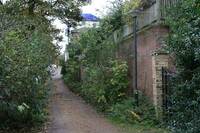- England
- Scotland
- France
- Holland
- Germany
- Italy
- Spain
- Portugal
- USA
- China
- Japan
- India
- Iran
- Advice
- Gardens
- England
- Scotland
- France
- Holland
- Germany
- Italy
- Spain
- Portugal
- USA
- China
- Japan
- India
- Iran
- Advice
- Garden Tours
Book: Landscape Planning and Environmental Impact Design: from EIA to EID
Chapter: Chapter 10 Sustainable green transport
Roads in housing areas are usually designed as scaled-down versions of distributor roads: they are impervious to water and excessively pervious to vehicular traffic. One alternative is to make lightly trafficked earth-bound roads or porous pavements [Fig: cross-ref to 29WGL in Floods]. They should be safe for pedestrians and cyclists but difficult to drive along at speeds above 10 km/hr. This can be achieved by designing a 'large bumpy footpath', over which cars are able to pass, instead of a 'small road'. Motorists should feel they are on a 'drive' in a private garden (Hass-Klau 1990). The surface treatment of such roads will depend on geological conditions in the locality. In sandy, gravelly and rocky areas, it may well be possible to do without a binder, to use uneven stone pitching, or to use a vegetated geotextile. Where there is a silt or clay substrate, it may be necessary to improve the local drainage and to raise the road surface above the general level. If vehicle speeds are too high, the residents association could sponsor a speed camera.
